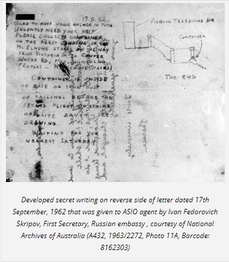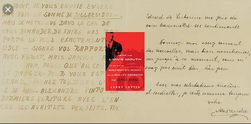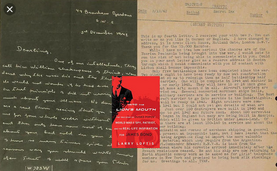A subtopic under the broad heading of 'Tradecraft', secret inks and secret writing were standard tools used for communication. Also referred to as 'Clandestine Communications'.

Ivan Fedorovich Skripov[]

Perhaps one of the best known Australian cases of the use of Secret Inks was the Skripov case.
In 1962 Ivan Fedorovich Skripov, First Secretary of the Russian Embassy in Australia, concealed an aluminium message container in one of the balustrades. It was meant to be collected by another operative ‘Sylvia’. Skripov had already used other Sydney public spaces to plant messages for her, including at a water meter under Sydney Harbour Bridge and a grave in one of Sydney’s cemeteries. Written with invisible ink, the messages had to be developed using a solution based on chemical crystals contained in pill capsules.
Copies of the messages leading to the McElhone Stairs are held in the National Archives, with one reading: “Glad to have your answer in time. Urgently need your help. Please collect container on the first landing of the McElhone Stairs on the way from Victoria Street to Cowper Wharf Road, Woollomooloo (Repeat – McElhone Stairs).”
Unfortunately for Skripov the operative “Sylvia” was in fact double agent Kay Marshall from the Australian Security Intelligence Organisation (ASIO). 3 The contained was seized and Skripov and his wife given seven days to leave the country.
DUSKO POPOV[]
A second example is a WW2 case where an Abwehr agent, Johan Jebsen, used the invisible ink method to communicate with double agent Dusko Popov.

View more images here: WW11 Spycraft
In some cases, the secret writing could only be revealed by the application of special chemicals to the paper.
Other times, the writing would appear only if Dusko ran a hot iron over the paper.In general, Popov was instructed to write with his invisible ink, in block letters, either between the lines or on the back of an innocuous (i.e., bogus) letter. Since the amount of information he was expected to convey was often significant, Dusko would have to first craft a long notional letter to the cover person (male or female) von Karsthoff was using at the time. MI5 prepared the "chickenfeed" (false but believable military information) Popov was to reveal in the secret writing.

In a letter to von Karsthoff on December 3, 1942, agent IVAN thanks his spymaster for sending 75,000 Portuguese escudos (roughly $10,000 today), and details his "findings" regarding Britain's five newly constructed battleships.
Secret Inks[]
Various fluids and chemicals were used extensively by all sides during WW2 and in the Cold War era and possibly still are. Amongst these you will find:
- Milk, common, readily available everyday use. Nothing suspicious about a bottle of milk in the agent's home. However, it was readily detected and so would have to have been the last resort. In order to develop the writing, all that needed to be done was to heat the paper. The writing implement could be a matchstick, a pin or similar. A UV light would detect the indentations left by the writing action.
- Lemon Juice, for a number of years in WW1, lemon juice was the standard but once again, easily detected and once again all that was required to develop the message was heat, a clothes iron for example. Once again, a simple pin or similar would suffice as a writing instrument. This method still left indentations so it was often detected with a UV light
- Water. Quite commonly used but it suffered from the obvious weakness in detection, that is until relatively recently when a group of Chinese scientists came up with a novel solution. They coated a special paper with chemicals including manganese so that when water was used to write the secret message all you need to do is to shine a UV light on the paper and up pops the message. The message can remain visible for up to 3 months. However, the Chinese went a step further, if you had secret message and you wanted to destroy it then you need a hairdryer, you blow it over the page and the message is gone but the paper remains reusable. Clever. The chemicals had the effect of removing any and all trace of the page having been written on so UV light was of no use.